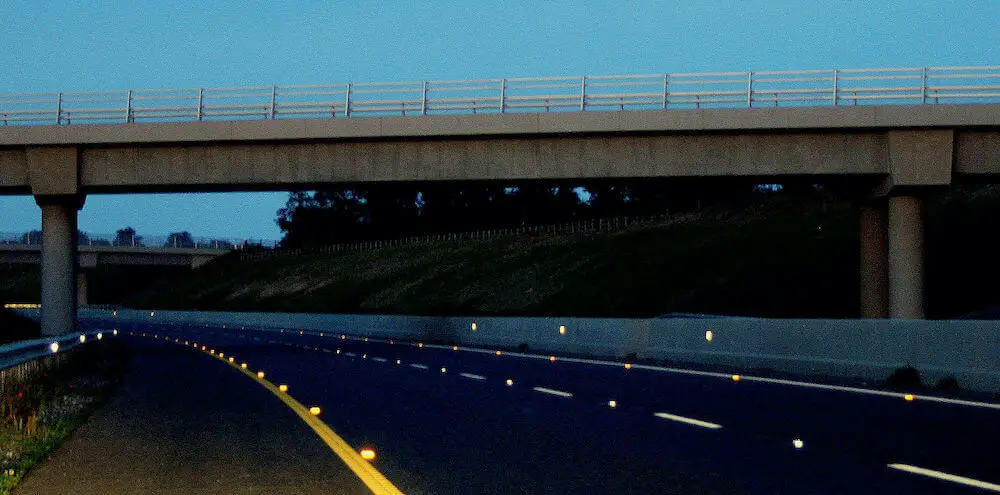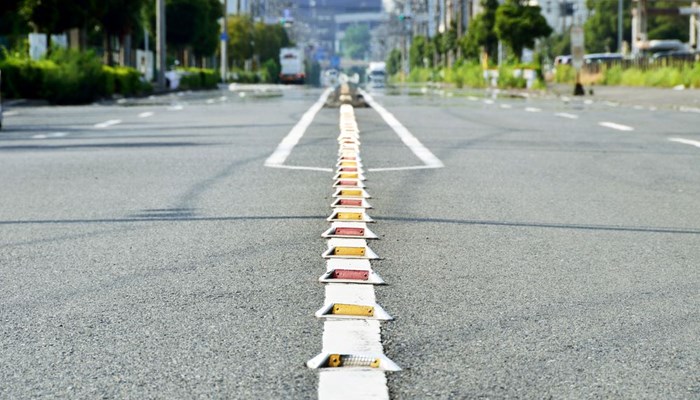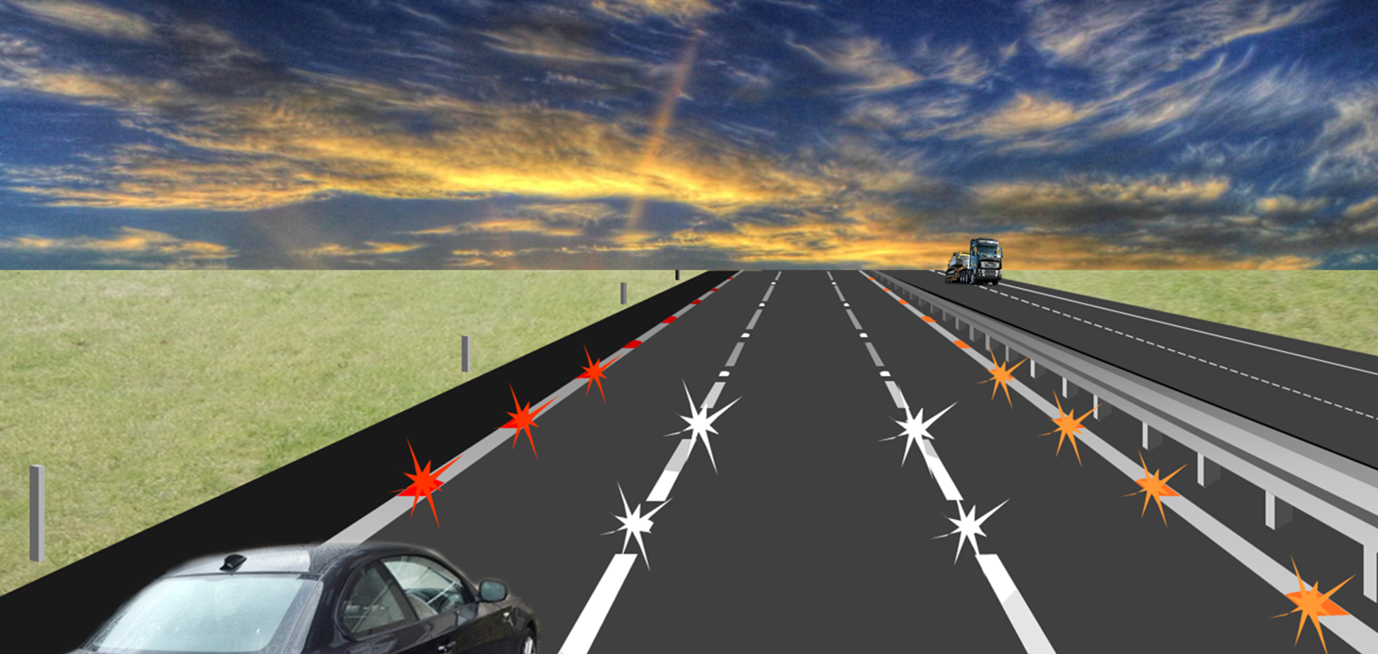Introduction
Where are Amber Reflective Studs Found on a Motorway, Motorways are the lifeblood of modern transportation systems, providing a network of high-speed roads to connect cities and regions. Safety on these roadways is paramount, and various measures are implemented to ensure smooth traffic flow and reduce the risk of accidents. One crucial element in this safety infrastructure is the use of amber reflective studs, strategically placed along the motorway to guide and alert drivers. In this article, we will delve into the significance of amber reflective studs, their purpose, and their specific placement on motorways.

I. The Purpose of Amber Reflective Studs
Amber reflective studs serve as an essential component of road safety, especially on high-speed motorways. Their primary purpose is to enhance visibility, particularly during adverse weather conditions or low-light situations. These studs are designed to reflect headlights, making them highly visible to drivers and contributing to overall road safety.
Must Read=learn to sit back and observe. not everything need – tymoff
A. Enhancing Nighttime Visibility
One of the primary roles of amber reflective studs is to improve visibility during the night. The reflective material embedded in these studs ensures that they stand out when illuminated by vehicle headlights, guiding drivers along the correct path and helping them maintain proper lane discipline.
B. Providing Guidance in Adverse Weather
In addition to nighttime visibility, amber reflective studs play a crucial role in adverse weather conditions, such as heavy rain, fog, or snow. Traditional road markings may become less visible under these circumstances, making it challenging for drivers to discern the correct lane. Amber studs act as beacons, guiding drivers even when the road markings are not clearly visible.
II. Placement of Amber Reflective Studs on Motorways
The strategic placement of amber reflective studs is a key aspect of their effectiveness. These studs are not randomly scattered but are instead positioned according to a specific system, contributing to the overall navigational assistance and safety of motorists.
A. Between Lanes
Amber reflective studs are typically found between lanes on motorways. Their placement assists drivers in maintaining proper lane discipline, especially during periods of low visibility. The regular intervals at which these studs are installed serve as a visual guide, ensuring that drivers can easily distinguish between lanes and stay within the designated paths.

B. Along the Edges
In addition to being placed between lanes, amber reflective studs are often positioned along the edges of the motorway. This placement helps drivers gauge the boundaries of the roadway, reducing the risk of unintentional lane departure. The combination of studs between lanes and along the edges creates a comprehensive system that aids drivers in navigating the motorway safely.
C. Exit and Entrance Ramps
Amber reflective studs are also commonly found on exit and entrance ramps of motorways. These ramps are critical points where drivers need clear guidance to smoothly merge or diverge from the main roadway. The placement of reflective studs in these areas helps drivers make informed decisions, reducing the likelihood of last-minute lane changes or abrupt maneuvers.
III. The Technology Behind Amber Reflective Studs
The effectiveness of amber reflective studs lies not only in their strategic placement but also in the technology that makes them visible and durable. Understanding the science behind these studs provides insights into their reliability and longevity.
A. Retroreflective Material
The key component of amber reflective studs is the retroreflective material embedded in them. This material is designed to bounce light back towards its source, meaning that when headlights shine on the studs, the reflected light is directed back to the driver. This property enhances visibility, making the studs stand out even in low-light conditions.
B. Durability and Weather Resistance
Amber reflective studs are engineered to withstand the rigors of weather and constant vehicular traffic. The materials used in their construction are chosen for their durability and resistance to environmental factors such as rain, snow, and temperature variations. This ensures that the studs remain effective in providing guidance and visibility over an extended period.
IV. The Role of Amber Reflective Studs in Accident Prevention
Beyond their primary function of aiding navigation, amber reflective studs play a crucial role in preventing accidents on motorways. Their contribution to road safety extends to various aspects of driving behavior and overall traffic management.
A. Reducing Lane Drifting
One of the leading causes of accidents on motorways is lane drifting, where drivers unintentionally veer into adjacent lanes. Amber reflective studs act as a visual cue, reminding drivers of their lane position and discouraging drifting. The continuous line of reflective studs creates a clear boundary, making it easier for drivers to stay within their designated lanes.
B. Minimizing Last-Minute Lane Changes
Amber reflective studs are strategically placed to provide consistent guidance along the motorway. This design discourages last-minute lane changes, as drivers can anticipate upcoming lane configurations well in advance. By minimizing abrupt maneuvers, the risk of collisions and traffic disruptions is significantly reduced.

V. Maintenance and Upkeep of Amber Reflective Studs
To ensure the ongoing effectiveness of amber reflective studs, regular maintenance and upkeep are essential. The process involves inspection, cleaning, and, if necessary, replacement of damaged or worn-out studs.
A. Inspection Routines
Transportation authorities and maintenance crews conduct routine inspections of motorways to assess the condition of reflective studs. These inspections may include visual checks and, in some cases, the use of specialized equipment to measure the reflectivity of the studs. Identifying and addressing any issues promptly helps maintain the overall safety of the motorway.
B. Cleaning Procedures
The visibility of amber reflective studs can be compromised by dirt, grime, or debris that accumulates over time. Cleaning procedures involve the use of specialized equipment, such as road sweepers, to remove surface contaminants and restore the reflective properties of the studs. Regular cleaning ensures that the studs remain highly visible, especially during adverse weather conditions.
C. Replacement of Damaged Studs
Despite their durability, amber reflective studs may become damaged due to accidents, extreme weather events, or general wear and tear. Prompt replacement of damaged studs is crucial to maintaining the integrity of the overall road safety system. Transportation authorities often have protocols in place for identifying and replacing defective studs in a timely manner.
VI. Future Developments in Road Safety Technology
As technology continues to advance, the field of road safety is not exempt from innovation. The future holds promising developments that could further enhance the effectiveness of amber reflective studs and overall motorway safety.
A. Smart Roadway Systems
The concept of smart roadways involves integrating technology into the infrastructure to enhance safety and efficiency. Future motorways may incorporate sensors, cameras, and communication systems that work in conjunction with amber reflective studs to provide real-time information to drivers. This could include alerts for adverse weather conditions, traffic congestion, or upcoming road hazards.

B. Advanced Materials
Ongoing research focuses on developing advanced materials with improved reflective properties. These materials could enhance the visibility of reflective studs even further, providing better guidance to drivers in a wider range of conditions. Innovations in materials may also contribute to the longevity and durability of reflective studs.
Conclusion
Amber reflective studs on motorways are a critical element in the comprehensive system designed to ensure road safety. Their strategic placement, coupled with the technology behind their retroreflective properties, plays a pivotal role in guiding drivers, minimizing accidents, and facilitating smooth traffic flow. As technology continues to advance, the future of road safety holds exciting possibilities for further innovations in materials and smart roadway systems, contributing to safer and more efficient journeys for all motorists. Regular maintenance and attention to the condition of these reflective studs are essential to preserving their effectiveness and upholding the standards of safety on our motorways

